2004 CHEVROLET CORVETTE park assist
[x] Cancel search: park assistPage 131 of 384
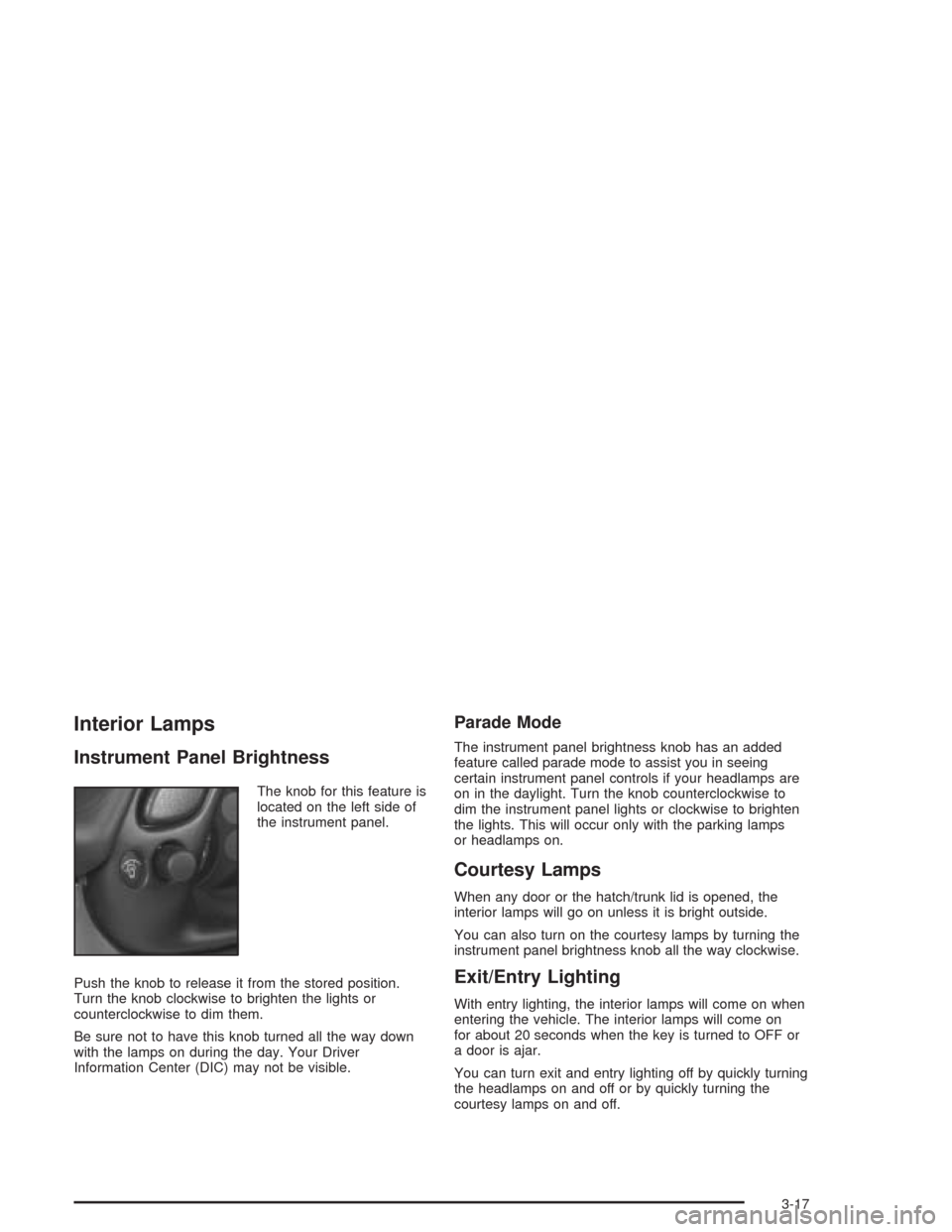
Interior Lamps
Instrument Panel Brightness
The knob for this feature is
located on the left side of
the instrument panel.
Push the knob to release it from the stored position.
Turn the knob clockwise to brighten the lights or
counterclockwise to dim them.
Be sure not to have this knob turned all the way down
with the lamps on during the day. Your Driver
Information Center (DIC) may not be visible.
Parade Mode
The instrument panel brightness knob has an added
feature called parade mode to assist you in seeing
certain instrument panel controls if your headlamps are
on in the daylight. Turn the knob counterclockwise to
dim the instrument panel lights or clockwise to brighten
the lights. This will occur only with the parking lamps
or headlamps on.
Courtesy Lamps
When any door or the hatch/trunk lid is opened, the
interior lamps will go on unless it is bright outside.
You can also turn on the courtesy lamps by turning the
instrument panel brightness knob all the way clockwise.
Exit/Entry Lighting
With entry lighting, the interior lamps will come on when
entering the vehicle. The interior lamps will come on
for about 20 seconds when the key is turned to OFF or
a door is ajar.
You can turn exit and entry lighting off by quickly turning
the headlamps on and off or by quickly turning the
courtesy lamps on and off.
3-17
Page 218 of 384
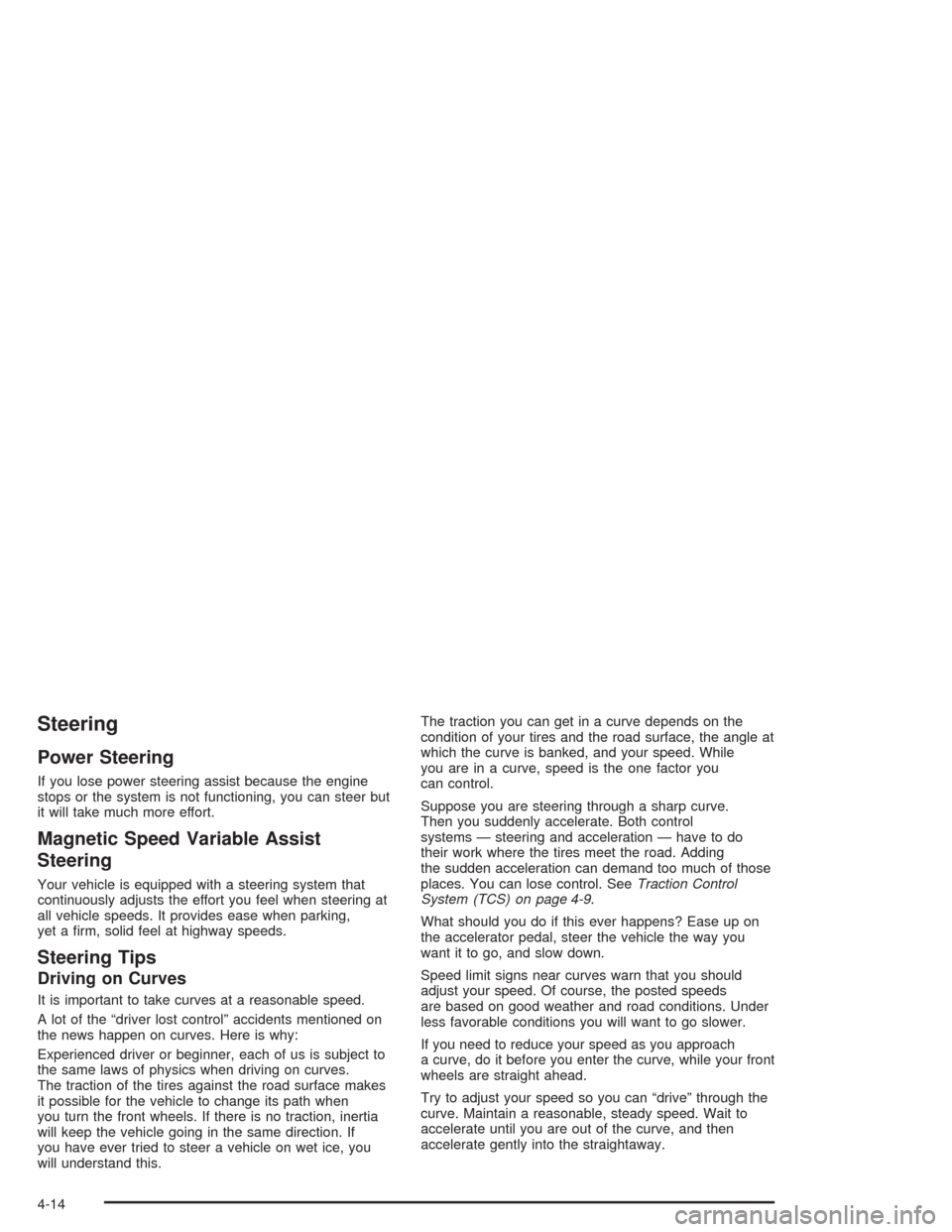
Steering
Power Steering
If you lose power steering assist because the engine
stops or the system is not functioning, you can steer but
it will take much more effort.
Magnetic Speed Variable Assist
Steering
Your vehicle is equipped with a steering system that
continuously adjusts the effort you feel when steering at
all vehicle speeds. It provides ease when parking,
yet a firm, solid feel at highway speeds.
Steering Tips
Driving on Curves
It is important to take curves at a reasonable speed.
A lot of the “driver lost control” accidents mentioned on
the news happen on curves. Here is why:
Experienced driver or beginner, each of us is subject to
the same laws of physics when driving on curves.
The traction of the tires against the road surface makes
it possible for the vehicle to change its path when
you turn the front wheels. If there is no traction, inertia
will keep the vehicle going in the same direction. If
you have ever tried to steer a vehicle on wet ice, you
will understand this.The traction you can get in a curve depends on the
condition of your tires and the road surface, the angle at
which the curve is banked, and your speed. While
you are in a curve, speed is the one factor you
can control.
Suppose you are steering through a sharp curve.
Then you suddenly accelerate. Both control
systems — steering and acceleration — have to do
their work where the tires meet the road. Adding
the sudden acceleration can demand too much of those
places. You can lose control. SeeTraction Control
System (TCS) on page 4-9.
What should you do if this ever happens? Ease up on
the accelerator pedal, steer the vehicle the way you
want it to go, and slow down.
Speed limit signs near curves warn that you should
adjust your speed. Of course, the posted speeds
are based on good weather and road conditions. Under
less favorable conditions you will want to go slower.
If you need to reduce your speed as you approach
a curve, do it before you enter the curve, while your front
wheels are straight ahead.
Try to adjust your speed so you can “drive” through the
curve. Maintain a reasonable, steady speed. Wait to
accelerate until you are out of the curve, and then
accelerate gently into the straightaway.
4-14
Page 318 of 384
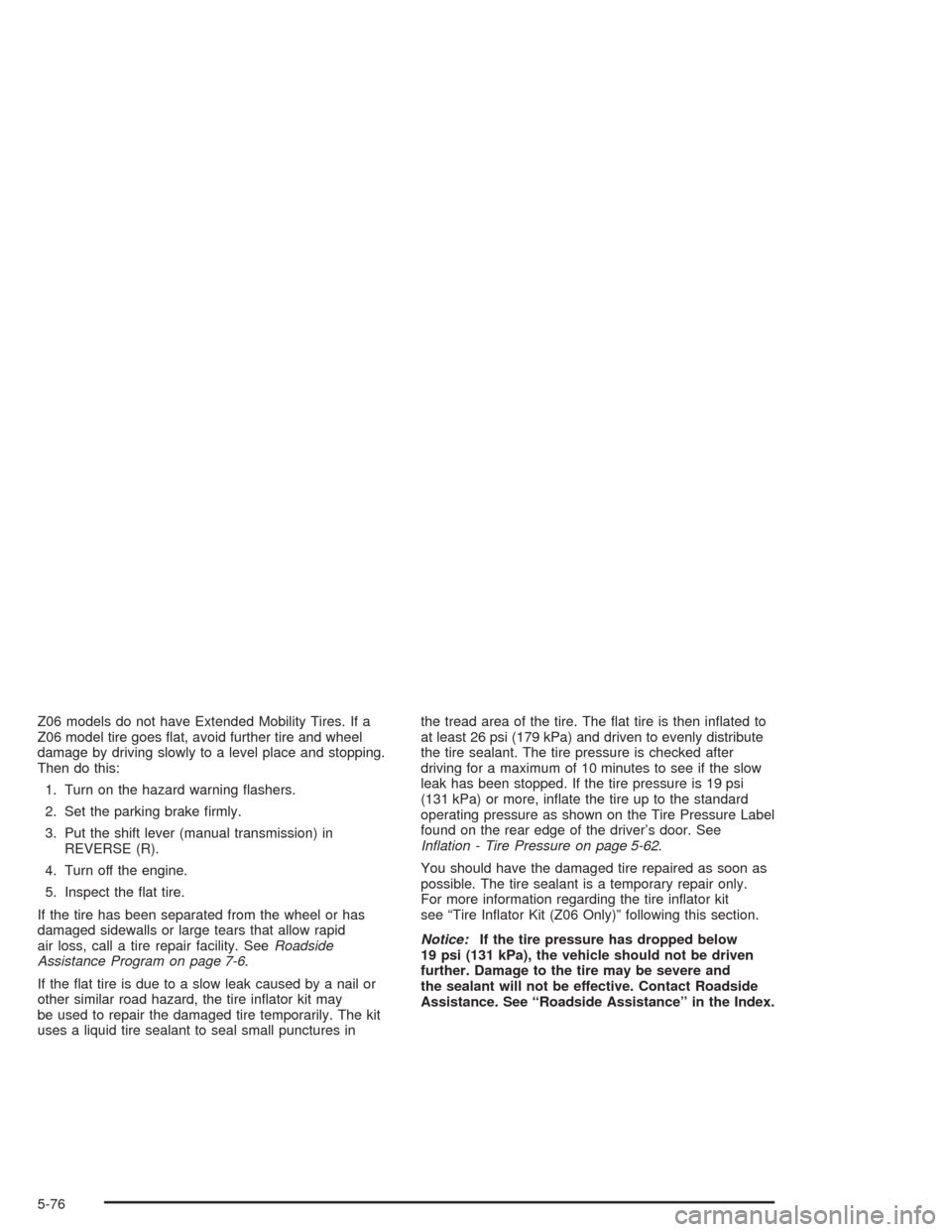
Z06 models do not have Extended Mobility Tires. If a
Z06 model tire goes flat, avoid further tire and wheel
damage by driving slowly to a level place and stopping.
Then do this:
1. Turn on the hazard warning flashers.
2. Set the parking brake firmly.
3. Put the shift lever (manual transmission) in
REVERSE (R).
4. Turn off the engine.
5. Inspect the flat tire.
If the tire has been separated from the wheel or has
damaged sidewalls or large tears that allow rapid
air loss, call a tire repair facility. SeeRoadside
Assistance Program on page 7-6.
If the flat tire is due to a slow leak caused by a nail or
other similar road hazard, the tire inflator kit may
be used to repair the damaged tire temporarily. The kit
uses a liquid tire sealant to seal small punctures inthe tread area of the tire. The flat tire is then inflated to
at least 26 psi (179 kPa) and driven to evenly distribute
the tire sealant. The tire pressure is checked after
driving for a maximum of 10 minutes to see if the slow
leak has been stopped. If the tire pressure is 19 psi
(131 kPa) or more, inflate the tire up to the standard
operating pressure as shown on the Tire Pressure Label
found on the rear edge of the driver’s door. See
In�ation - Tire Pressure on page 5-62.
You should have the damaged tire repaired as soon as
possible. The tire sealant is a temporary repair only.
For more information regarding the tire inflator kit
see “Tire Inflator Kit (Z06 Only)” following this section.
Notice:If the tire pressure has dropped below
19 psi (131 kPa), the vehicle should not be driven
further. Damage to the tire may be severe and
the sealant will not be effective. Contact Roadside
Assistance. See “Roadside Assistance” in the Index.
5-76
Page 369 of 384
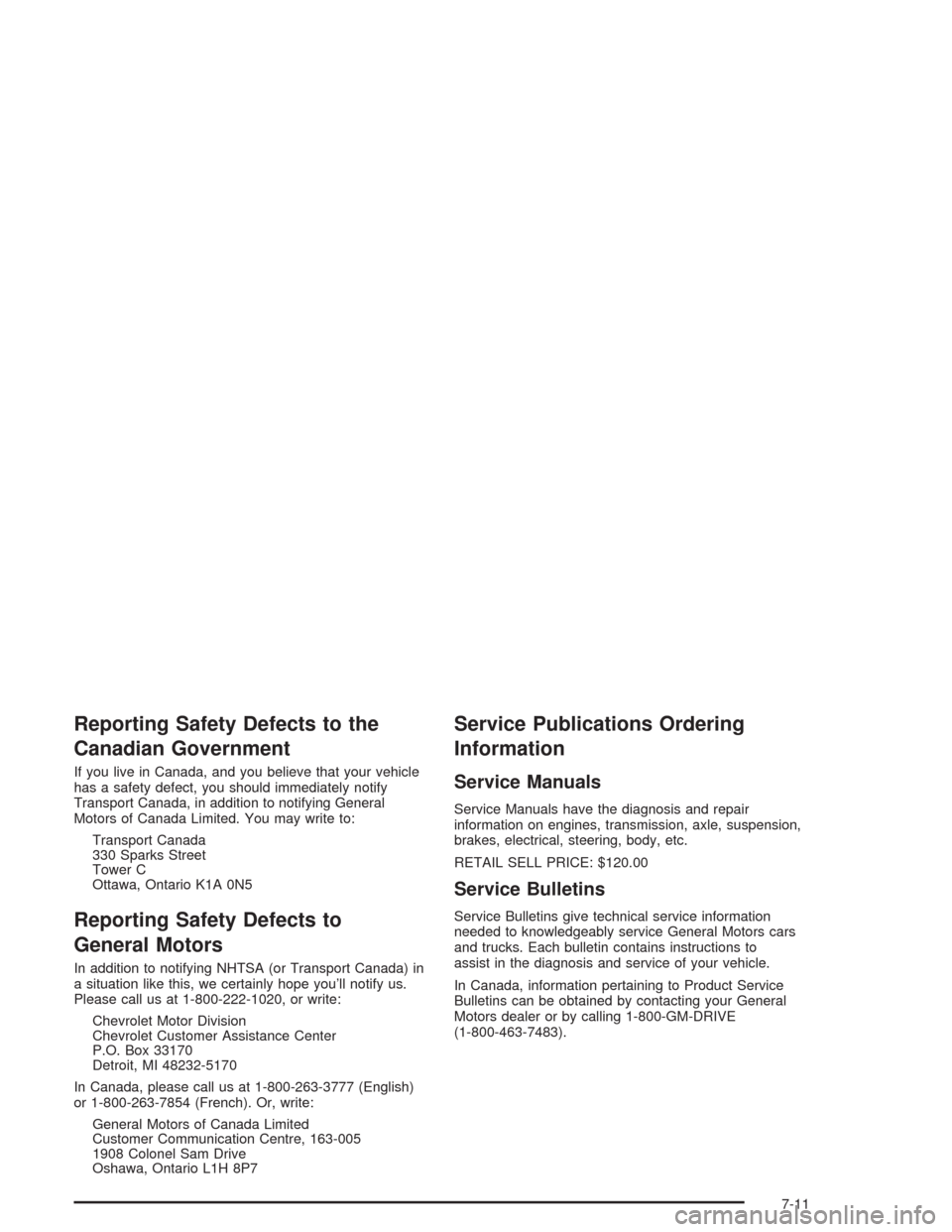
Reporting Safety Defects to the
Canadian Government
If you live in Canada, and you believe that your vehicle
has a safety defect, you should immediately notify
Transport Canada, in addition to notifying General
Motors of Canada Limited. You may write to:
Transport Canada
330 Sparks Street
Tower C
Ottawa, Ontario K1A 0N5
Reporting Safety Defects to
General Motors
In addition to notifying NHTSA (or Transport Canada) in
a situation like this, we certainly hope you’ll notify us.
Please call us at 1-800-222-1020, or write:
Chevrolet Motor Division
Chevrolet Customer Assistance Center
P.O. Box 33170
Detroit, MI 48232-5170
In Canada, please call us at 1-800-263-3777 (English)
or 1-800-263-7854 (French). Or, write:
General Motors of Canada Limited
Customer Communication Centre, 163-005
1908 Colonel Sam Drive
Oshawa, Ontario L1H 8P7
Service Publications Ordering
Information
Service Manuals
Service Manuals have the diagnosis and repair
information on engines, transmission, axle, suspension,
brakes, electrical, steering, body, etc.
RETAIL SELL PRICE: $120.00
Service Bulletins
Service Bulletins give technical service information
needed to knowledgeably service General Motors cars
and trucks. Each bulletin contains instructions to
assist in the diagnosis and service of your vehicle.
In Canada, information pertaining to Product Service
Bulletins can be obtained by contacting your General
Motors dealer or by calling 1-800-GM-DRIVE
(1-800-463-7483).
7-11
Page 372 of 384
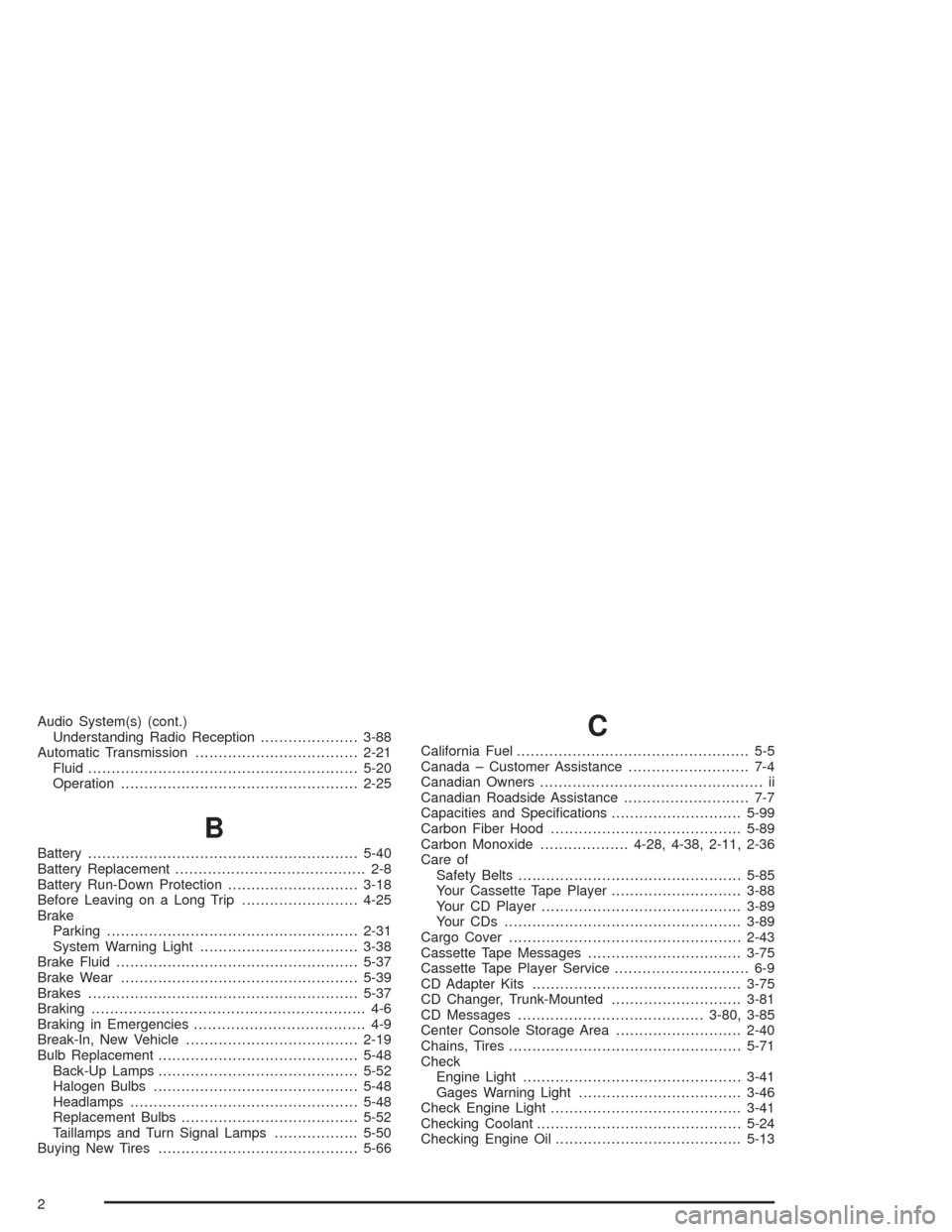
Audio System(s) (cont.)
Understanding Radio Reception.....................3-88
Automatic Transmission...................................2-21
Fluid..........................................................5-20
Operation...................................................2-25
B
Battery..........................................................5-40
Battery Replacement......................................... 2-8
Battery Run-Down Protection............................3-18
Before Leaving on a Long Trip.........................4-25
Brake
Parking......................................................2-31
System Warning Light..................................3-38
Brake Fluid....................................................5-37
Brake Wear...................................................5-39
Brakes..........................................................5-37
Braking........................................................... 4-6
Braking in Emergencies..................................... 4-9
Break-In, New Vehicle.....................................2-19
Bulb Replacement...........................................5-48
Back-Up Lamps...........................................5-52
Halogen Bulbs............................................5-48
Headlamps.................................................5-48
Replacement Bulbs......................................5-52
Taillamps and Turn Signal Lamps..................5-50
Buying New Tires...........................................5-66
C
California Fuel.................................................. 5-5
Canada – Customer Assistance.......................... 7-4
Canadian Owners................................................ ii
Canadian Roadside Assistance........................... 7-7
Capacities and Specifications............................5-99
Carbon Fiber Hood.........................................5-89
Carbon Monoxide...................4-28, 4-38, 2-11, 2-36
Care of
Safety Belts................................................5-85
Your Cassette Tape Player............................3-88
Your CD Player...........................................3-89
Your CDs ...................................................3-89
Cargo Cover..................................................2-43
Cassette Tape Messages.................................3-75
Cassette Tape Player Service............................. 6-9
CD Adapter Kits.............................................3-75
CD Changer, Trunk-Mounted............................3-81
CD Messages........................................3-80, 3-85
Center Console Storage Area...........................2-40
Chains, Tires..................................................5-71
Check
Engine Light...............................................3-41
Gages Warning Light...................................3-46
Check Engine Light.........................................3-41
Checking Coolant............................................5-24
Checking Engine Oil........................................5-13
2
Page 379 of 384
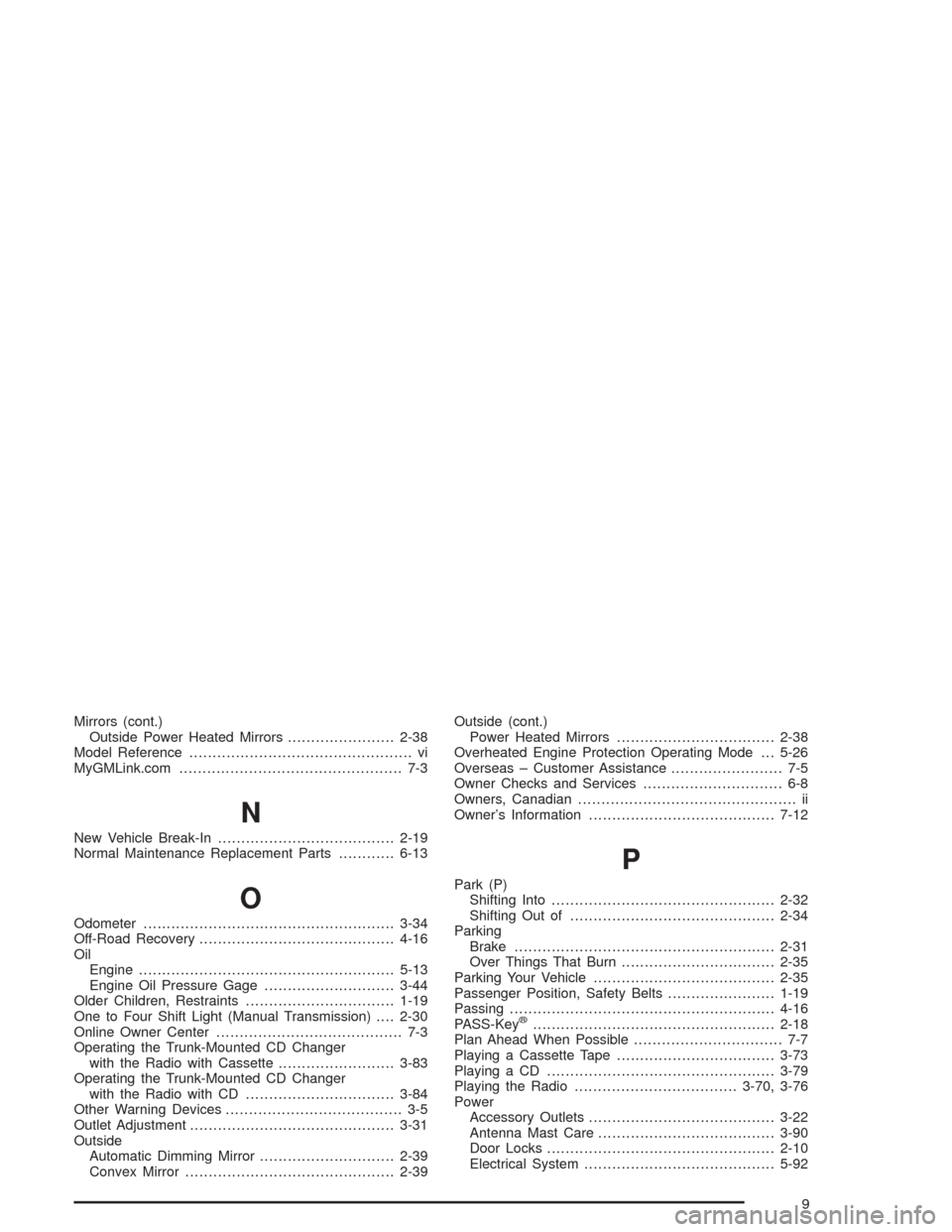
Mirrors (cont.)
Outside Power Heated Mirrors.......................2-38
Model Reference................................................ vi
MyGMLink.com................................................ 7-3
N
New Vehicle Break-In......................................2-19
Normal Maintenance Replacement Parts............6-13
O
Odometer......................................................3-34
Off-Road Recovery..........................................4-16
Oil
Engine.......................................................5-13
Engine Oil Pressure Gage............................3-44
Older Children, Restraints................................1-19
One to Four Shift Light (Manual Transmission)....2-30
Online Owner Center........................................ 7-3
Operating the Trunk-Mounted CD Changer
with the Radio with Cassette.........................3-83
Operating the Trunk-Mounted CD Changer
with the Radio with CD................................3-84
Other Warning Devices...................................... 3-5
Outlet Adjustment............................................3-31
Outside
Automatic Dimming Mirror.............................2-39
Convex Mirror.............................................2-39Outside (cont.)
Power Heated Mirrors..................................2-38
Overheated Engine Protection Operating Mode . . . 5-26
Overseas – Customer Assistance........................ 7-5
Owner Checks and Services.............................. 6-8
Owners, Canadian............................................... ii
Owner’s Information........................................7-12
P
Park (P)
Shifting Into................................................2-32
Shifting Out of............................................2-34
Parking
Brake........................................................2-31
Over Things That Burn.................................2-35
Parking Your Vehicle.......................................2-35
Passenger Position, Safety Belts.......................1-19
Passing.........................................................4-16
PASS-Key
®....................................................2-18
Plan Ahead When Possible................................ 7-7
Playing a Cassette Tape..................................3-73
Playing a CD.................................................3-79
Playing the Radio...................................3-70, 3-76
Power
Accessory Outlets........................................3-22
Antenna Mast Care......................................3-90
Door Locks.................................................2-10
Electrical System.........................................5-92
9
Page 383 of 384
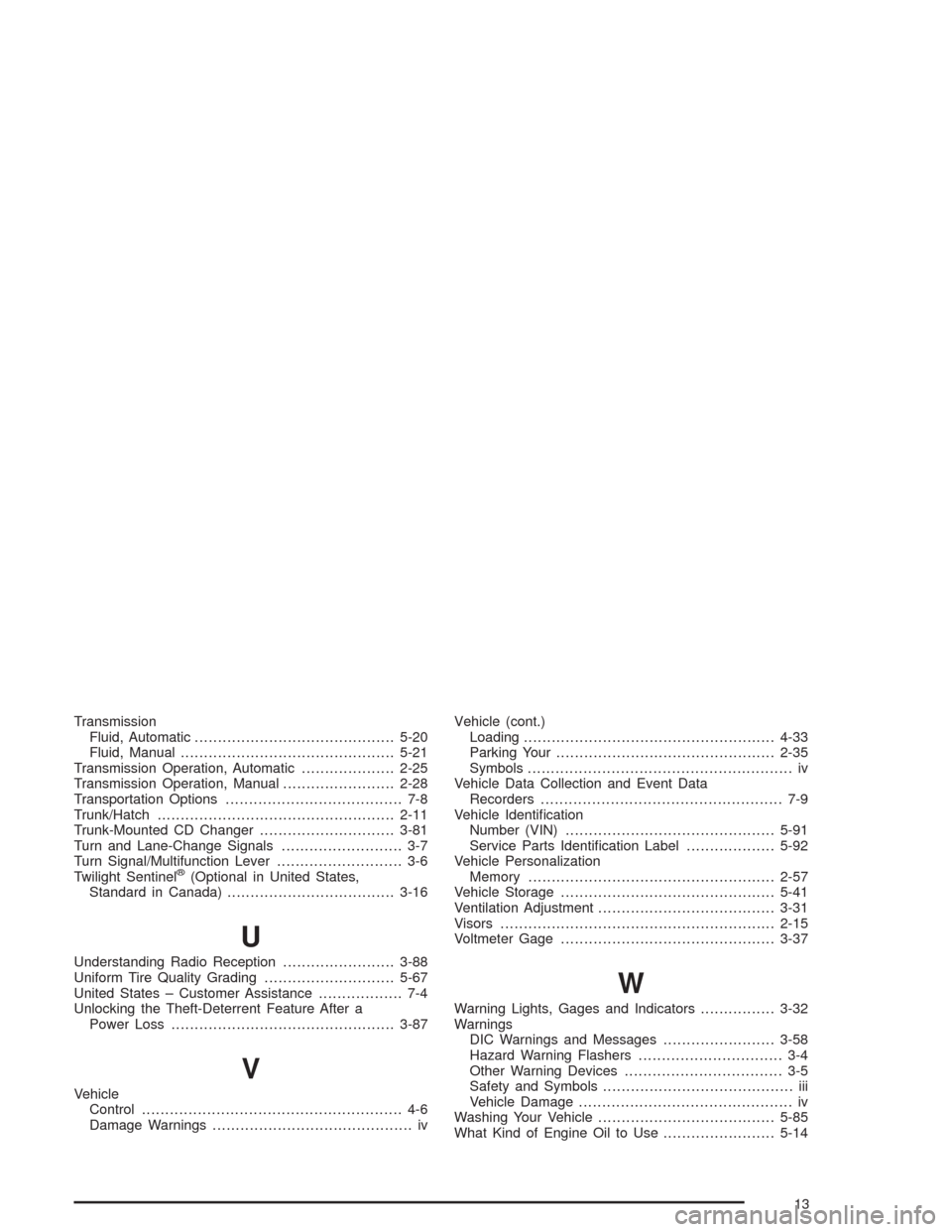
Transmission
Fluid, Automatic...........................................5-20
Fluid, Manual..............................................5-21
Transmission Operation, Automatic....................2-25
Transmission Operation, Manual........................2-28
Transportation Options...................................... 7-8
Trunk/Hatch...................................................2-11
Trunk-Mounted CD Changer.............................3-81
Turn and Lane-Change Signals.......................... 3-7
Turn Signal/Multifunction Lever........................... 3-6
Twilight Sentinel
®(Optional in United States,
Standard in Canada)....................................3-16
U
Understanding Radio Reception........................3-88
Uniform Tire Quality Grading............................5-67
United States – Customer Assistance.................. 7-4
Unlocking the Theft-Deterrent Feature After a
Power Loss................................................3-87
V
Vehicle
Control........................................................ 4-6
Damage Warnings........................................... ivVehicle (cont.)
Loading......................................................4-33
Parking Your...............................................2-35
Symbols......................................................... iv
Vehicle Data Collection and Event Data
Recorders.................................................... 7-9
Vehicle Identification
Number (VIN).............................................5-91
Service Parts Identification Label...................5-92
Vehicle Personalization
Memory.....................................................2-57
Vehicle Storage..............................................5-41
Ventilation Adjustment......................................3-31
Visors...........................................................2-15
Voltmeter Gage..............................................3-37
W
Warning Lights, Gages and Indicators................3-32
Warnings
DIC Warnings and Messages........................3-58
Hazard Warning Flashers............................... 3-4
Other Warning Devices.................................. 3-5
Safety and Symbols......................................... iii
Vehicle Damage.............................................. iv
Washing Your Vehicle......................................5-85
What Kind of Engine Oil to Use........................5-14
13